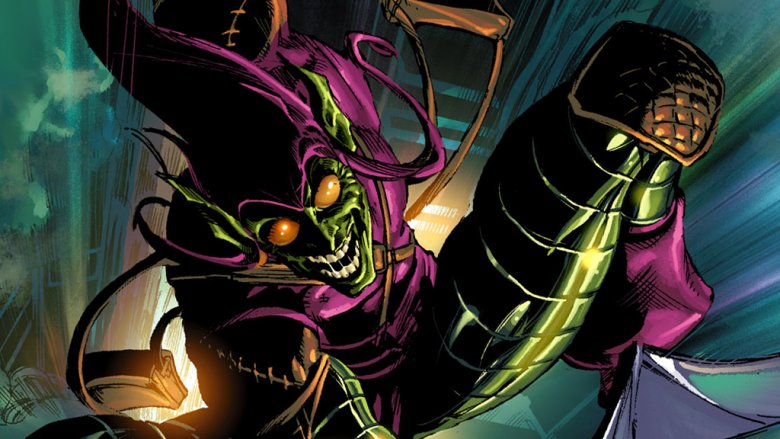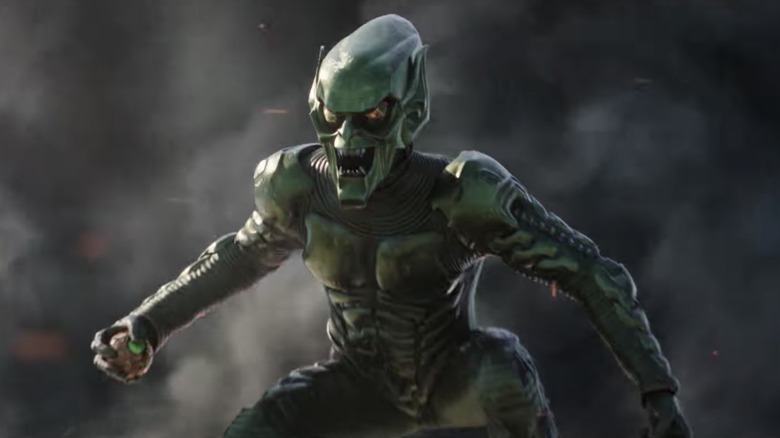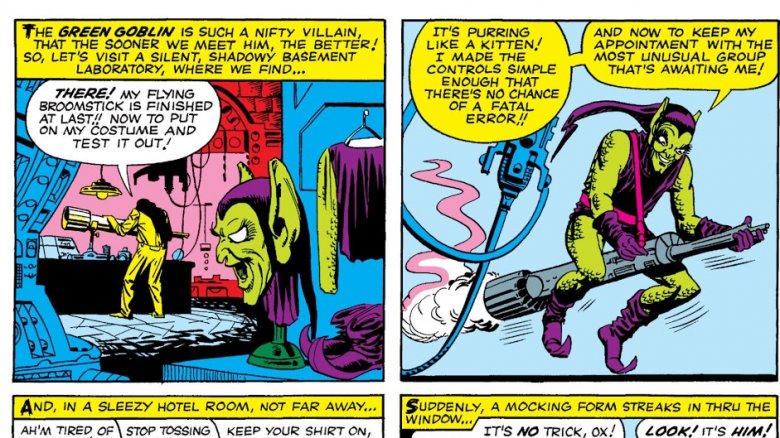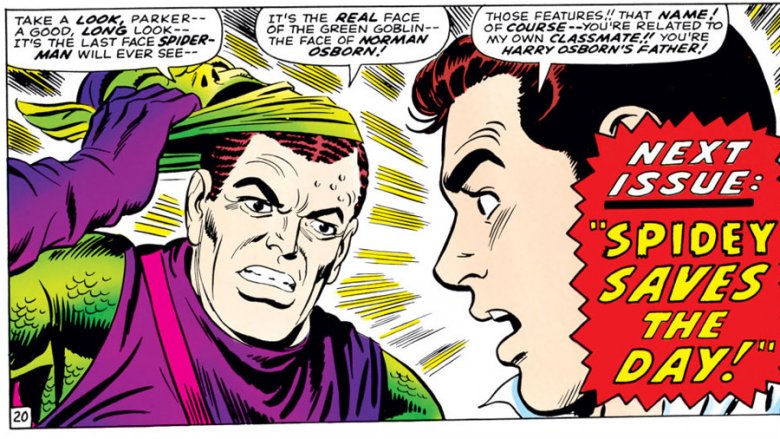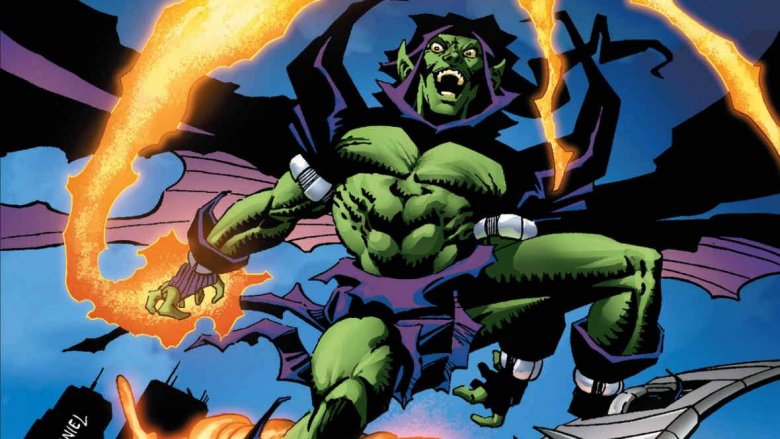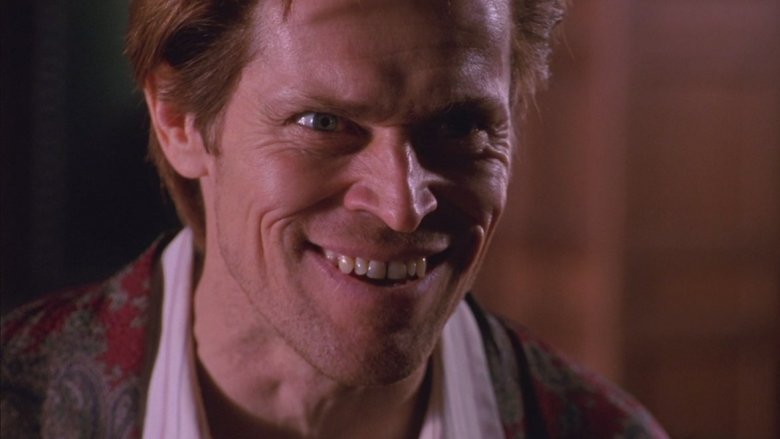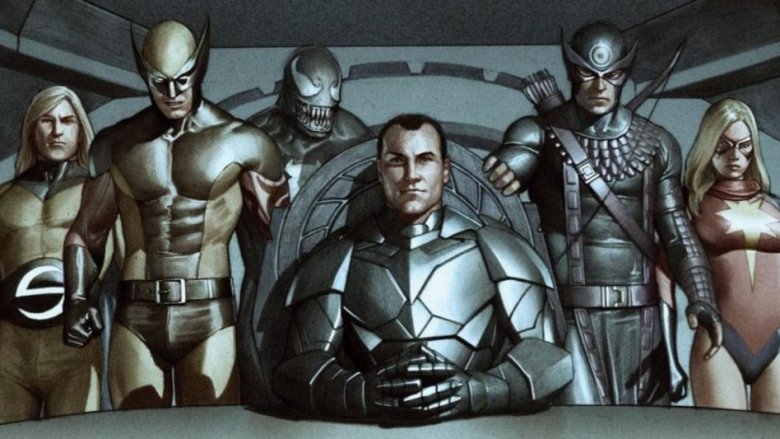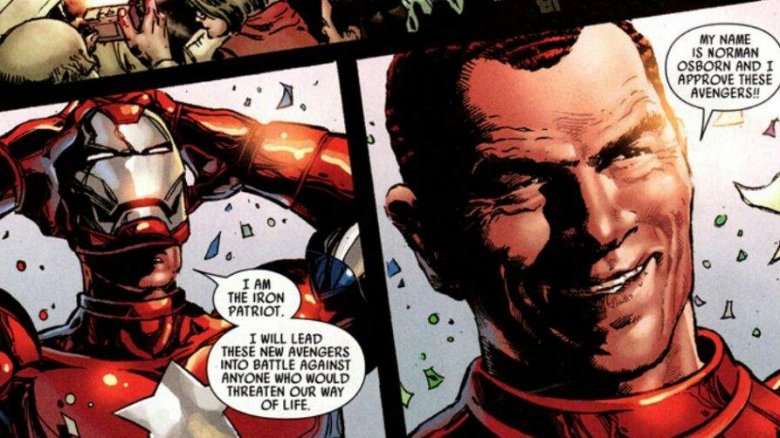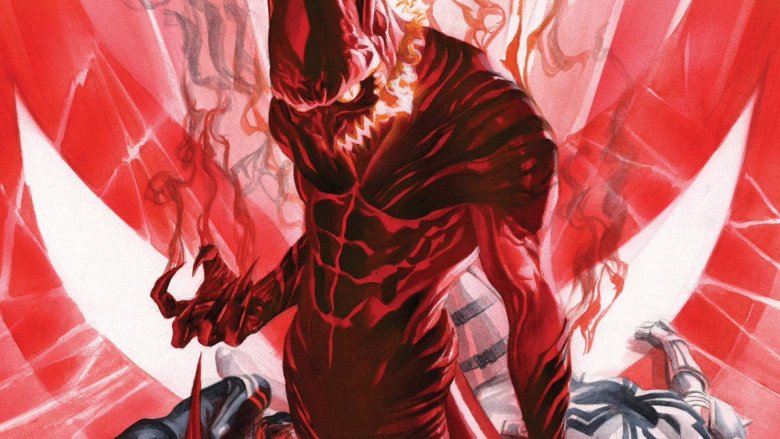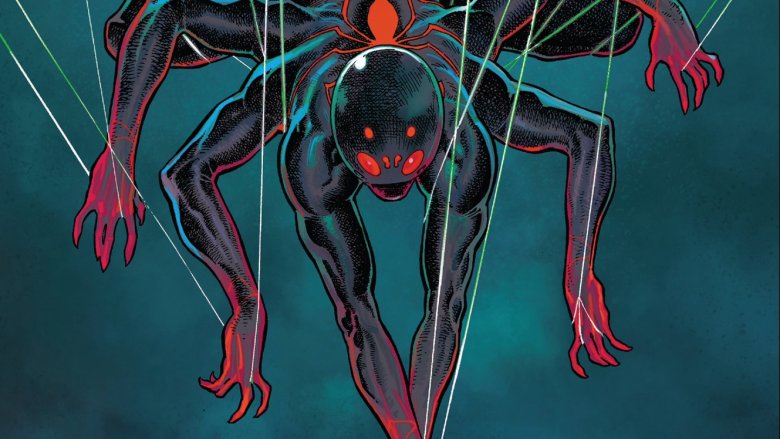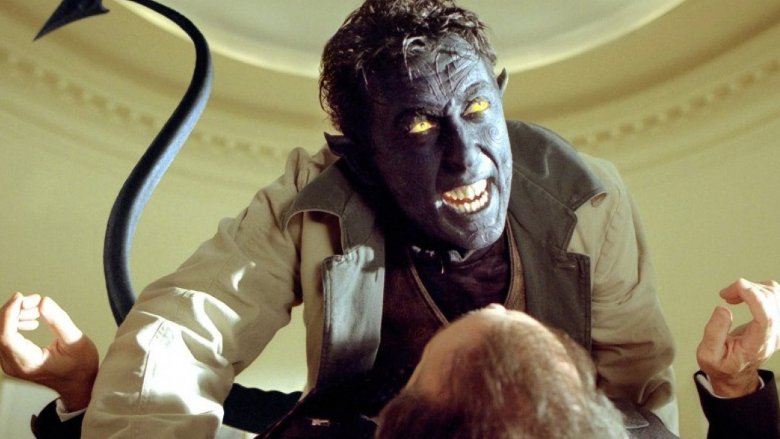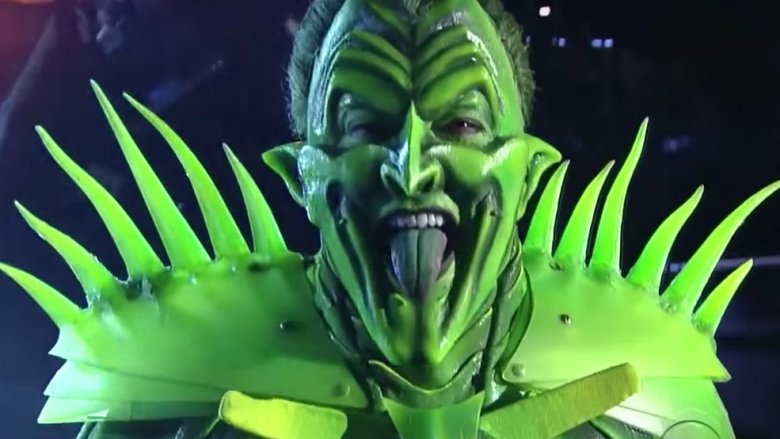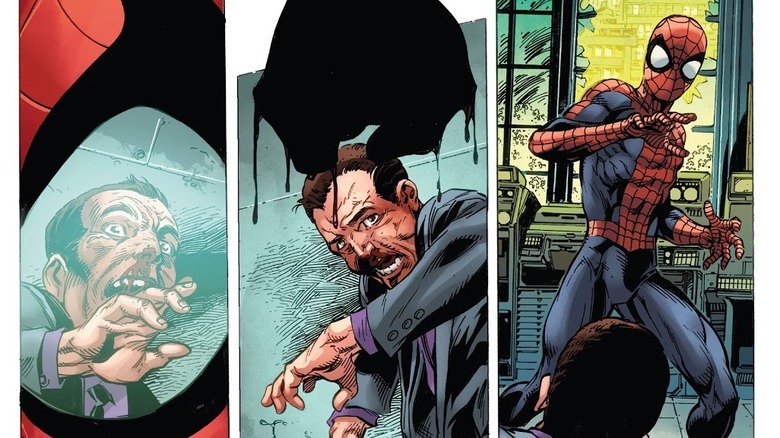The Untold Truth Of Green Goblin
First appearing in 1964's Amazing Spider-Man #14, Green Goblin was the villain who brought Spider-Man's "super" conflicts to a much more personal level. Most superheroes struggle between their personal and superheroic lives to some extent, but that conflict defines Spider-Man more than nearly any other comic book crimefighter. As Green Goblin, Norman Osborn was the first enduring Spider-Man villain plucked right from Peter Parker's social life. He was the father of Harry Osborn, Peter Parker's best friend. His villainy raised the stakes of the conflict in every way and this became a hallmark of the ongoing stories of Peter Parker. When things go sideways for Peter, everything's on the table — any friend or loved one could die, any secret could be unearthed, and every corner of his life will be affected. Spider-Man doesn't just get his back broken like Batman; he gets divorced and outed in the press and loses his job and revealed to not actually be the real Peter Parker. That's the Osborn effect.
Before 2006's line-wide event Civil War and the subsequent Secret Invasion, Norman Obsorn was mainly a Spidey-centric villain. After fooling the world into thinking he was on the side of the angels, Parker's nemesis became a global-level threat to every cape in the Marvel Universe — a role he might fill in the movies if he ever actually shows up in the MCU. Here's the untold truth of the Green Goblin.
Is Green Goblin on the way to the MCU?
Early in June 2019, the anonymous leaker known as "Roger Wardell" unleashed a torrent of supposed leaks about MCU's Phase 4. While it's all unconfirmed, it's only fair to mention he leaked details about Avengers: Endgame months before release which wound up being true.
Among other things, Wardell has major claims about the Green Goblin. According to the alleged leaks, Phase 4's primary antagonist won't be a purple guy from outer space, but someone much closer to home: Norman Osborn will supposedly serve as the next Big Bad of the MCU.
We now know that, in fact, Willem Dafoe's version of Green Goblin is on his way to the MCU. Dafoe will reprise the villainous role in Spider-Man: No Way Home, but it remains to be seen whether he'll replace Thanos as Marvel's main villain. Considering Osborn and the other Spider-Man villains appearing will be travelers from other parts of the multiverse, one of the more likely outcomes of the story would seem to be their return to their respective realities. Not to mention Jonathan Majors' Kang the Conqueror has often been named as the Big Bad of Phase 4. Time, as they say, will tell.
Green Goblin's glider came later
As much as Green Goblin's bat-shaped gliders have become inseparable from images of the villain in the funny pages or in live-action adaptations, in Green Goblin's first appearance his trademark glider was nowhere to be found. Instead, Goblin's premiere in Amazing Spider-Man #14 featured the invention of what Osborn called his "flying broomstick."
The flying broomstick only looks like a broomstick if you're thinking of one of the more expensive Quidditch broomsticks from the Harry Potter series. It looks like a stick and Green Goblin flies on it, though how he flies on it is a bit of a mystery. As much practice and training something like the Goblin Glider — which makes its first appearance a few issues later in Amazing Spider-Man #17 — would doubtless necessitate to operate it correctly, its wings allow Green Goblin to stand on it. The flying broomstick, on the other hand, is just a not-particularly-large stick. Ant-Man might be able to sit on it, but that's about it. Any normal-sized person would, at best, find themselves spinning around on the thing, but only if they could successfully hold on to it with their legs. In most likelihood, they'd just hit the ground like someone whose dad really wanted a Soul Stone.
Norman almost wasn't the Green Goblin...maybe
Green Goblin's identity was initially a mystery to readers. From the character's first appearance in Amazing Spider-Man #14, it would be two years, 25 issues, and one major artist change before the Green Goblin was unmasked as Norman Osborn. That artist change helped feed an urban legend that's survived for years.
Amazing Spider-Man #38 was Spidey co-creator Steve Ditko's final issue as artist. John Romita, Sr. replaced Ditko with Amazing Spider-Man #39 which happens to be when Goblin's identity is revealed. Goblin being unmasked as soon as Ditko left the title led many fans to believe that Ditko was against Osborn being Green Goblin and that this was why he left.
Spider-Man's other co-creator seemed to confirm half of the fan theory. In a 2011 issue of the magazine Alter Ego, Stan Lee said Ditko wanted Goblin to be "just some character that we had never seen before," but Lee insisted that would be cheating readers.
However, as Brian Cronin points out in his 400th Comic Book Legends Revealed column, by the time Ditko left Amazing Spider-Man he and Lee were embroiled in enough conflicts — mostly financial — that Ditko's departure from Amazing Spider-Man was inevitable regardless of creative differences. Cronin also reproduces part of a 2009 essay in which Ditko not only denies Lee's claims that he was against Osborn being the Goblin, but says he always knew Osborn would be the Goblin and made plenty of creative choices to facilitate that future reveal.
Norman was one of five Green Goblins
Norman Osborn is hardly the only character to bear the name Green Goblin. In fact, while he's the original, most memorable, and most enduring Green Goblin, he's only one of five different characters to have used the name.
Just as Norman's son Harry (James Franco) becomes New Goblin in 2007's Spider-Man 3, the character assumed the name of Green Goblin in 1974's Amazing Spider-Man #136 after discovering Peter Parker was Spider-Man. Harry loses his memories of being a villain while battling the third Green Goblin, but regains them years later.
The third Goblin is Dr. Bart Hamilton, a psychiatrist who treats Harry Osborn. Hamilton uses hypnosis to learn Green Goblin's secrets, including the location of his hideout and equipment. Visiting the hideout, Hamilton gives in to temptation and becomes the next Goblin in 1978's Amazing Spider-Man #176.
Green Goblin #4 tries his hand at the hero business. Phil Urich, son of Daily Bugle reporter Ben Urich, recovers the Goblin equipment after Harry Osborn's death and even enjoys a short-lived solo title. Urich retires after his equipment is damaged beyond repair during the 1996 Onslaught line-wide event.
After returning from the dead for a few decades, Norman Osborn has an underling construct a genetically engineered slave to be the new Green Goblin in 2000's Peter Parker: Spider-Man #18. He dresses as the green Goblin, acts like the Goblin, and does it all to help Osborn convince the world he was never the Green Goblin in the first place.
Dafoe loved being the Green Goblin
Nearly two decades after 2002's Spider-Man helped usher in the dominance of super-heroes on the big screen, Willem Dafoe has wonderful things to say about his experience playing the Green Goblin. Speaking to GQ in February 2019, Dafoe talked about how the Osborn/Green Goblin duality appealed to him. "[Y]ou could play these scenes where it would switch from comedy to drama in a line," Dafoe told GQ. "There's a couple of scenes that still make me laugh, because they're so double-edged, and they go back and forth between being really heavy and really kind of silly." Dafoe singled out the scene in which Osborn and Green Goblin have a conversation with one another in a mirror, saying director Sam Raimi gave him Robert Louis Stevenson's The Strange Case of Dr. Jekyll and Mr. Hyde to read for the scene.
Dafoe's recounting of his experience is filled with the word "fun" and he smiles throughout the telling. It must have been pretty fun considering he remembers it so fondly in spite of the physical challenges. In a behind-the-scenes feature on the Spider-Man DVD, Dafoe claimed to have endured between "40 and 50 hours of fittings" of the Goblin suit before the design was finalized. "It was really uncomfortable to wear," Dafoe said on the feature. "It was so tight and so heavy that, after a whole day in that thing, you felt like you had just gone 12 rounds."
Green Goblin replaced Tony Stark
Eventually, Green Goblin became more than just Spider-Man's antagonist. How? Well, fittingly, he was helped out by a bunch of green skinned guys with pointy ears.
During the 2006 Marvel Comics line-wide event Civil War, Norman Osborn is appointed director of a new version of the Thunderbolts, which is tasked with capturing unregistered superheroes. Osborn's Thunderbolts include villains a bit nastier than the team known for reformed crooks is used to, including guys like the kill-crazy villain Bullseye and the deadly symbiote Venom.
Osborn's leadership role in the Thunderbolts puts him in a position to be in the right place at the right time when the 2008 line-wide event Secret Invasion comes along. Focused on the shape-shifting Skrulls, Secret Invasion has most of Marvel's heroes uniting against the alien threat. Osborn succeeds in gaining the public's trust by shooting and killing the Skrull queen Veranke. When the dust settles, Tony Stark is blamed for the Skrull infiltration and ousted as director of S.H.I.E.L.D. while Osborn is made the head of the new military force H.A.M.M.E.R. From there, his power keeps growing.
Green Goblin was an Avenger
When Green Goblin gains control of H.A.M.M.E.R., the Superhero Registration Act is still in effect and most of the surviving former Avengers are considered outlaws. Osborn takes advantage of the situation and forms his own team of Avengers in Dark Avengers.
Most of Osborn's Dark Avengers are villains renamed and rebranded as replacements of more traditional Avengers. Bullseye is disguised as Hawkeye, Daken as Wolverine, Venom as Spider-Man, and Moonstone as Ms. Marvel. Noh-Varr, a.k.a. Marvel Boy, joins the team as a new Captain Marvel. The only holdouts from pre-Osborn Avengers teams are the mentally unstable Sentry and the morally questionable war god Ares.
His corruption doesn't stop with the Avengers. Osborn also puts together a Dark X-Men team with Mystique, Namor, Daken, Emma Frost, and others.
Osborn's influence is finally put to bed at the conclusion of the 2010 line-wide event Siege in which Osborn leads an invasion of Asgard and is finally imprisoned for his crimes.
Green Goblin became Iron Patriot
If you've seen 2013's Iron Man 3, then you know the name Iron Patriot. What you may not know is that, in the comics, Iron Patriot originally had nothing to do with James "Rhodey" Rhodes.
Combining the design of Stark's Iron Man armor with the colors of Captain America, Norman Osborn creates the Iron Patriot armor so he can use it to lead his Dark Avengers. The armor gives him most of Iron Man's abilities, though unlike Stark's armor, it isn't based on repulsor technology.
Osborn creates a separate suit of armor for a sidekick, but with a very specific and dark purpose. Norman creates the American Son armor for his son Harry, but his the younger Osborn would eventually discover Norman did it just so he could eventually kill Harry in order to create public sympathy for himself.
Norman remains Iron Patriot until his plans fall apart in Siege. He eventually escapes from The Raft prison and forms a new team of Dark Avengers in the hopes of recapturing his old suit and getting his revenge on the heroes who defeated him. He fails, and soon after he resumes his life as the Green Goblin.
Carnage plus Green Goblin equals Red Goblin
Norman Osborn's most sickeningly powerful transformation comes at the end of 2018's Amazing Spider-Man #798.
Osborn is one of the first people to figure out Peter Parker is Spider-Man, but the events of the 2007 storyline One More Day takes that knowledge away from him. In Amazing Spider-Man #797, when J. Jonah Jameson mentions Green Goblin's murder of Gwen Stacy, the words spark something in Osborn and cause him to remember who Spider-Man is. With this new/old revelation, Goblin demands Spidey quit being a hero or he'll kill all the people in Parker's life like Aunt May and Mary Jane Watson.
Osborn attacks the offices of the Daily Bugle in Amazing Spider-Man #798, and after an intense battle with Spider-Man he winds up impaled on debris. Spidey thinks Goblin's dying, but the issue ends with the Carnage symbiote — who Osborn snatched from a warehouse in Amazing Spider-Man #794 — appearing and bonding with Osborn to create the Red Goblin.
As the Red Goblin, Osborn is more powerful than ever and doesn't even suffer the usual symbiote vulnerabilities to fire and sound. Red Goblin continues the hunt for Parker's loved ones, and Spidey is only able to stop the murders of Aunt may and MJ with the help of Venom, Anti-Venom, and the Superior Octopus. Borrowing Venom's symbiote and allied with his old friend Flash Thompson, a.k.a. Anti-Venom, Spidey is finally able to defeat the Red Goblin — but Flash is killed in the battle.
He's a Spider-Man
The 2014 Marvel Comics event Spider-Verse inspired the 2018 movie Spider-Man: Into the Spider-Verse by introducing dozens of alternate reality versions of Spider-Man. The sequel to the original event — 2018's Spider-Geddon – introduced some new alternate Spideys, including a Norman Osborn version.
In Edge of Spider-Geddon #4, we meet the Spider-man of Earth-44145. In that reality, Norman Osborn gains proportional spider abilities instead of Peter Parker, as well as growing four extra arms. Norman's son Harry infiltrates Oscorp and captures Osborn's Kobold suit (a variation on the Green Goblin suit). Throughout the issue, we read a letter Peter Parker had sent to Harry upon the event of his death. The letter urges Harry to stop his father, and Harry dies trying to do just that.
This version of Norman Osborn is forcefully recruited into the new Spider-Army by Spider-Punk, but by the end of Spider-Geddon it seems clear everyone would have been better off leaving him home. Allying himself only with Spiders-Man of Earth-11580 — a version of Spider-Man that is simply thousands of spiders formed together in a Spider-Man suit — the Osborn Spidey abandons the Spider Army and destroys the Web of Life and Destiny that allows the different Spider heroes to travel between and monitor other realities. After Spider-Geddon, he was the final adversary for the reformed Otto Octavius in the 2019 volume of Superior Spider-Man.
Nightcrawler almost became Green Goblin...sort of
One of the low points in the history of Spider-Man adaptations is the infamous Broadway musical Spider-Man: Turn Off the Dark. The production was plagued with cast injuries and creative team shake-ups. Turn Off the Dark's official opening was delayed so many times it wound up with the longest preview period in Broadway history. One of the many snags the production had to face was recasting the story's main villain — the Green Goblin.
Alan Cumming, who plays the blue-skinned teleporter Nightcrawler in 2003's X2: X-Men United, was the original pick for Spider-Man's Jekyll/Hyde bad guy. In April 2010 — two months after the musical's originally scheduled opening date — Cumming announced he was backing out of the production. A scheduling conflict arose with the CBS series Cumming was starring in, The Good Wife, and the Turn Off the Dark production would need to find someone else to fill his shoes.
Though he didn't offer many details, Cumming apparently did not enjoy working with director Bryan Singer on X2. So considering everything that happened with Turn Off the Dark, it seems likely he dodged suffering through a second unpleasant superhero adaptation experience.
He loved it even if you hated it
Broadway actor Patrick Page is no stranger to playing the bad guy. When he was first asked to read for the part of Norman Osborn in Spider-Man: Turn Off the Dark, Page was busy playing the murderous Scar in the stage production of The Lion King. Speaking with DC Theatre Scene in 2011, Page said he "absolutely adore[d]" playing villains. Page reminisced about bad guys on TV shows and in musicals who "always looked like they were having the most fun!" He singled out Cyril Ritchard who played Peter Pan's Captain Hook in the 1955 TV Movie as well as mentioning actors like Burgess Meredith and Cesar Romeo who played villains on the '60s Batman show.
Page endured an extraordinary physical toll while playing the Green Goblin. The hardest thing about the role, Page told Broadway.com, was performing "eight shows a week in full prosthetics." He shared with DCTS that the first time they applied the Goblin make-up, prosthetics, etc. It took "three-and-a-half hours," and that, for live performances, that change had to somehow be shortened to "under 30 seconds."
In spite of the media pouncing on Turn Off the Dark, Page remembers his time on the show with gratitude and joy. In April 2019 Page described his time as the Goblin to Theatermania as "one of the greatest experiences I've ever had." He said the cast and crew of the show became a family and that he "wouldn't really trade the experience."
He's reformed in the comics ... for now
Most recently in the comics, Norman Osborn has turned to the side of the angels, though you could make the argument it wasn't by his own choice. Shortly after he was made the director of Ravencroft Institute by Mayor Wilson Fisk — aka the Kingpin — Osborn found himself in the crosshairs of a resurrected vigilante. The supernatural villain Kindred had brought the Sin-Eater back to life, and this time he had powers worthy of his namesake. Rather than just killing his prey, the new Sin-Eater could wipe away his target's sins, which is precisely what he does to Norman in 2020's Amazing Spider-Man #50.
While he believes Sin-Eater is going to kill him, Norman instead wakes to find his evil urges have disappeared, replaced only with remorse for everything he's done. Understandably, it takes Spider-Man a while to accept that Osborn's changes are genuine, and the wall-crawler beats the hell out of him in 2021's Amazing Spider-Man #57. Spidey fortunately stops himself before he goes too far.
For the time being, Osborn seems to be on the right side of things. In fact, he does what little he can to help Spider-Man during the 2021 Sinister War event, but considering who he is, it's only a matter of time before the Green Goblin flies again.
